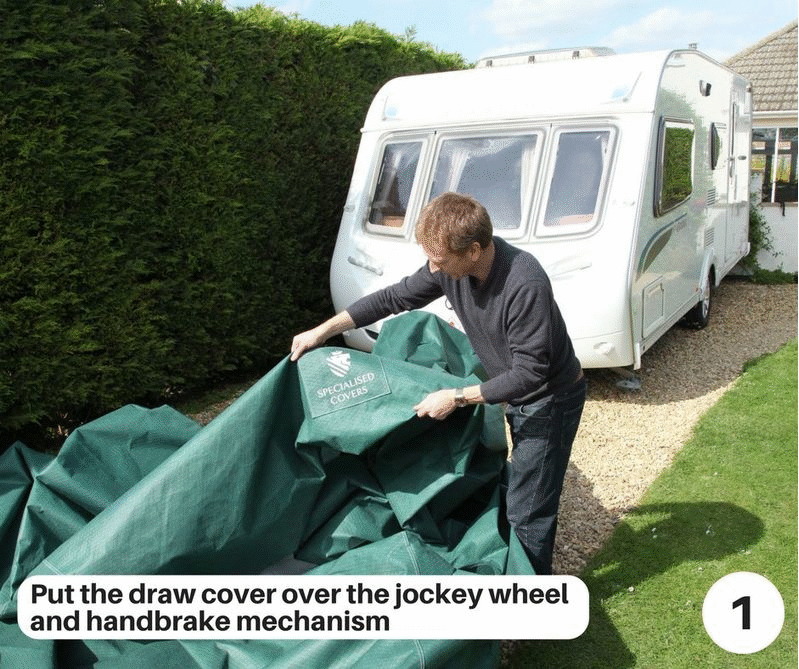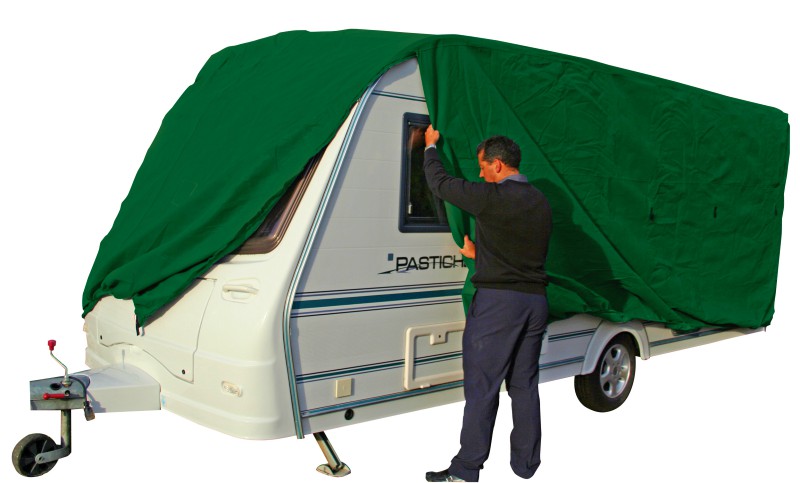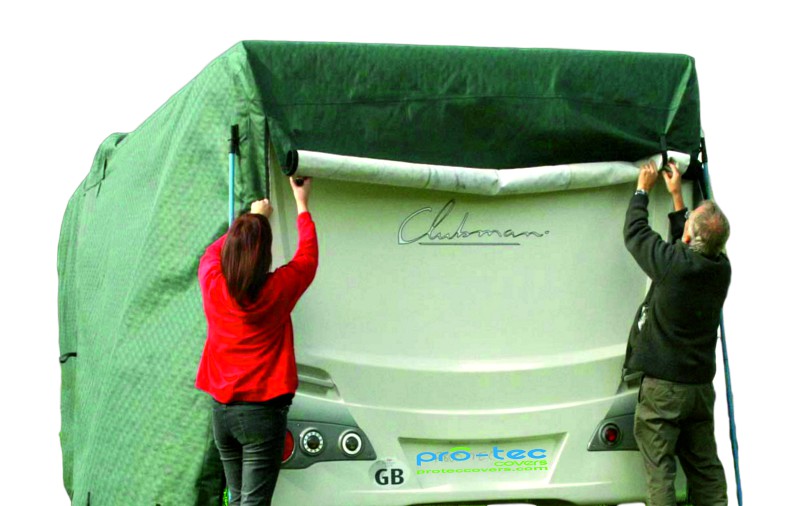Caravan covers: Get covered
The advantages of using a caravan cover are obvious: they keep the caravan clean and protected from tree debris and bird dirt. But how easy are they to put on and take off your caravan? It’s the question everyone asks.
By Val Chapman
And the bigger the caravan, the more daunting the task may seem - until you get to know more.
Enter colleague Kim Hampson, his Sterling Eccles Moonstone and his caravan cover, tailor-made for the Moonstone by Specialised Covers.
Kim and his wife Kate bought the Moonstone – their first caravan- last year from Raymond James Caravans. They crammed in seven breaks last year and then got Specialised to make a cover before laying the caravan up for the winter.
Kim says: "A caravan is a lot of money, so you want to keep it in as good condition as possible, protected from the weather. It also looks neater, clothed in its dark green cover."
Getting ready for caravanning season
The Moonstone is about to be uncovered for its first trip out of the year, to Greetham, near Horncastle.
Managing Ed John Sootheran and I arrive for the occasion, with camera and laptop to record the sequence. It's the first time Kim has taken the cover off, and he doesn't know how easy or hard the task will be. Then once it's off and the sequence photographed, the cover is going to go back on again.
The cover comes with two telescopic poles. Kim unclips buckles on straps that go around the corner steadies and under the caravan. We ease upwards the rear corner sections that have elasticated sections to ensure a snug fit. I remark on the foam inserts that are on the ends of the awning channel to protect the cover from any risk of snagging.
Kim and I insert the plastic-protected ends of the poles into pockets at the top corners of the cover and begin to raise the fabric. I think the height is going to defeat me and John takes over (later I realise that this isn't the case and the poles do take care of medium stature).
The cover quickly begins to come off as Kim and John walk towards the front of the caravan, holding it aloft on the poles. Within seconds it is on the ground, upside down, so there is no risk of grit or dirt getting onto the soft inside.
The Moonstone comes out of its cover shining. Kim remarks that it’s just as clean as when he gave it its pre-cover shower back in October.
Even though it's going straight back on, we simulate putting it away in the ample-sized back supplied. We fold and roll and fold and roll again, and it's clear pretty quickly that the cover will go into its back without too much pulling and pushing.
The fabric feels quite lights in weight when it's on the ground but would we be saying the same thing when it comes to lifting it back onto the caravan?
Fitting a caravan cover
It's now time to put the cover to its 'fitting test'. We put the drawbar cover (that comes with the kit) in place, to ensure no grease from the jockey wheel or hitch comes into contact with the caravan cover.
We open out the fabric to expose the pockets into which we insert the tops of the poles. As we unroll it we can see dollops of bird dirt that would otherwise have the landed on the roof of the caravan; that's one important reason to consider buying a cover, we decide; bird muck can damage caravan paintwork if not washed off pretty promptly.
The cover begins to go on smoothly and quickly with John and Kim hoisting it aloft with the poles. I grabbed John's camera, and there is one point I observe through the lens a slightly comical scene. Both members of the cover crew became enveloped in fabric, masses of green material held high above the Moonstone like a Viking square sail, and we are glad there is not even a slight breeze to fill it.
As the cover nears the rear of the Moonstone, Kim opens the caravan door and stands in the entrance to gain extra height from which he gives the fabric a helping hand along its travels.
In less than 15 minutes we are easing the elastic sections over the rear lower corners, and Kim starts to put the securing straps back in place. The drawbar cover adheres to the front skirt of the cover with Velcro, and our task is complete. Had we not been pausing for photos, we could have easily fitted the cover inside 10 minutes.
Watch the slides showing how we fitted the cover below!

Specialised Covers
There are two types of caravan cover; those that are designed to be universal and those tailor-made for particular caravan models. Specialised only makes custom-made covers.
Specialised Covers use a triple-layer fabric; all are breathable. And the covers can be put on which the caravan is wet so long as the caravan is clean, specialised makes Gavin Hughes, Specialised Covers Managing Director, explains.
The company introduced the telescopic poles as standard equipment to eliminate any difficulties. “Previously we recommended customers use soft-bristled brushes to ease the cover along the caravan,” Gavin tells us.
Covers also come with window protectors although Gavin says they're unneeded except for use on older caravans which may have protruding windows. The foam protectors for the ends of awning channels aren’t strictly necessary either, says Gavin, again unless your caravan is older and may have an awning channel with slightly rough ends.
Solar panel
More advice from Gavin, this time on solar panels. Check if you need your solar panel to be exposed when the caravan is not in use, he advises:
"Check if tracker/alarm runs off its battery rather than the caravan's battery; some do, some don't. Unless it runs off the caravan battery, we recommend you don't specify a Perspex section to the roof where the solar panel sits.
“We only recommend this is if necessary because that part of the cover is not breathable, and also because the more stitching and seams there are the more weak points you have." That's about the longevity of course, which leads me to ask about the expected lifetime of a cover.
"Some customers keep them for 12 years; others for four or five years, it all depends on how long it's in use for and therefore how much you expose it to UV. If you only use it in the winter, when the exposure to UV is less than in summer, a cover will last longer before the waterproof and breathability factors start to deteriorate.”
And some advice on colours: Specialised offers a choice of three colours, grey, green and blue. Blue lasts the shortest length of time before UV affects it; grey lasts the longest, closely followed by green.
“We guarantee them for three years. And the cost? £299-£399 depending on the length of the caravan. Kim Hampson again: "You pay a lot of money for a caravan, so it pays to look after it; buying a cover is a no-brainer."
Talking about looking after things, advice from Gavin about caring for a cover:
"Try to remove leaves. Clean it with warm water and a sponge, using nothing harsher than washing up liquid if you need soap." And when you pack it away? ‘The fabric is breathable, so it goes into the bag slightly damp it will not go mouldy, although it stands to reason that the drier it is, the better."
Kampa

Awning manufacturer Kampa also makes caravan covers. These are universal; made to fit specific caravan body lengths but not tailor made to specific models.
Mark Lawless, Kampa’s Managing Director, explains:
“We can cater for caravans with a body length of between 3.65m) and (8.5m) and widths up to 2.50m. We've been selling our covers since 2007, and they have earned a reputation for being reliable. We offer a two-year guarantee on the material.
“Kampa covers are breathable and are not designed to be 100% waterproof, says Mark: “They keep the worst of the weather off the caravan and stop it becoming dirty or covered in mould.”
They make them from a three-layer material. Mark explains:
“The outer layer is designed to reflect the sun's harmful rays, the middle layer is a waterproof micropore breathable film that allows water vapour to escape while preventing rainfall from penetrating. The inner layer is soft and non-abrasive and will not harm the caravan or windows. An added advantage of using a cover is that it protects the caravan interior from heat build-up and UV.”
Kampa covers are lightweight, designed to be easy to install. They have four zips, one at each corner, that makes it easy to fit onto the caravan and gives easy access during storage. An elasticated hem and sturdy webbing straps keep the cover securely on the caravan. When not in use the cover can be rolled up and stored in the carry bag supplied.
Prices start from £99.
Pro-tec Covers

Pro-tec Covers uses the Protex003 material, a breathable fabric developed exclusively for this manufacturer. It's breathable and manufactured in the UK.
All of Protec’s covers are bespoke; the company has over 15,000 fully-tailored patterns, Managing Director Paul Smith explained to Caravan magazine. “Pro-tec Covers is a family owned business that designs and manufactures covers in Bradford, West Yorkshire.
"Pro-tec's catalogue is vast, says Paul. As well as for caravans, the company makes other bespoke covers: "Just a quick call or email to our team, and we will be able to make a cover," says Paul.
Pro-tec’s fitting system has been developed to save time as well as making light work of the task, the company says.
Called the Easy Fit System, it involves the use of poles (supplied), similarly to Specialised Covers. The key difference is that the whole of the back panel of the Pro-tec cover rolls up and secures with Velcro.
How it works…
Pro-tec emphasises the need to wash your caravan to avoid getting any grit or dirt trapped against your cover and the caravan.
Again similarly to Specialised, buyers are advised first to fit the A-frame cover that comes with the caravan cover. You insert the poles into D-rings on both sides of the rear of the cover and then slide the cover from the front to the back of the caravan. You then unroll the back panel and secure it in place with the Velcro straps.








Recent Updates
Caravan showers: all you need to know
In this guide, we’ll discuss the different types of showers, how they work, and how to fit an external shower point to your caravan ...
Caravan towing: all you need to know
Towing a caravan may seem daunting initially, but a few simple tips can make the journey enjoyable and ...
All you need to know about towbars & towballs
Flange, detachable, swan neck, retractable – towbar technology choice is bewildering. Don’t worry. We’ll ...
Caravan WiFi: everything you need to know
Caravan holidays are the ultimate way of getting away from it all, although we sometimes need a link to the ...
Caravan insurance: all you need to know
Navigating the world of caravan insurance can feel like a daunting task. Fear not, as this comprehensive ...
Buying a caravan: what you need to know
Let us guide you through some of the complicated things to think about when first looking at buying a ...
Caravan awnings: a buyers' guide
Caravan awnings are a fantastic addition to any caravan as they are one of the simplest, quickest and most ...
Caravan electrics: avoid tripping out
All caravan owners have overloaded their mains supply at some time. Here’s how to master caravan electrics ...
Caravan heating systems: a quick guide to caravanning warmth
When winter is here, you’ll be glad of a decent caravan heating system if you’re out touring. Here’s how the ...
Caravan damp: a complete guide
There's little more guaranteed to strike fear into the heart of a caravan owner than the word 'damp'. But if ...
Other Articles
Caravan jockey wheels: the definitive guide
A well-functioning caravan jockey wheel can make all the difference to manoeuvring away from the towcar, especially if you don't have a caravan mover ...
Caravan cooking recipes
Caravan cookery inspirational ideas. No need to stress out in the kitchen with these quick and easy ...
Caravan bike racks: a complete guide
Exploring the beautiful surroundings while on a caravan trip is undeniably one of the greatest joys of the ...
A guide to solar power in your caravan
Not that many years ago, mains electrical hook-up on campsites was considered a bit of a luxury, and, for ...
The ultimate guide to caravan layouts
Choosing the right layout or floorplan of your caravan is an all-important part of the buying process – find ...
A guide to seasonal caravan pitches
Our in-depth guide to finding and securing seasonal caravan pitches on your favourite campsite ...
Caravan weights and payloads: a quick guide
The terminology of caravan weight – MIRO, MTPLM, noseweight, kerbweight, payload, weight plate upgrade – is ...
The ultimate guide to caravan motor movers
Caravan motor movers: everything you need to know about remote control caravan manoeuvring ...
Caravan cleaning: All you need to know
Whether you’re taking the caravan out for the first time or it’s just in need of a spruce up, our guide will ...
18 essential items for camping with your dog
Camping is for the whole family – including our four-legged members. Here's what you'll need to keep your dog ...